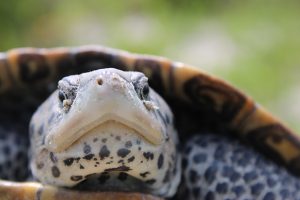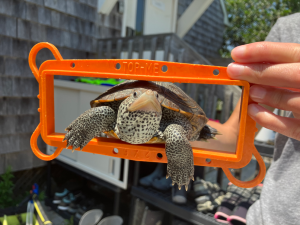by Brian Williamson, Research Scientist
If you frequent shore communities of southern New Jersey in the summer months, you have likely seen a northern diamondback terrapin, either a hatchling scrambling to the nearest vegetation, a female hastily crossing a road to nest, or a smaller-bodied male basking on the bank of a tidal creek. These reptiles are uniquely adapted for an existence in brackish water. No other reptile in our region, and no other turtle in North America, is capable of lifetime residence in saltmarshes. Not only are these turtles a unique part of our local biodiversity, but they are an extremely important species in saltmarsh ecosystems. Studies suggest terrapins may keep populations of marsh grazers in check, helping ensure the continued health of saltmarshes.
 Unfortunately, this species faces growing threats to their continued existence. Countless terrapins drown each year as bycatch in enclosed crab pots, and impacts from this often unseen threat have led to local declines and population collapse in parts of their range. The loss of terrapins from bycatch is particularly high along the Delaware Bay, but little is known about these terrapin populations. Coastal development and sea level rise impact terrapin habitat throughout the state, and remaining nesting habitat is often near roadways, leading to road mortality. Recently, artificial nesting habitats have been constructed using clean dredged material. They are more resilient to sea level rise and farther from roadways, but questions about their effectiveness remain. Additionally, information about where terrapins brumate (the reptilian equivalent of hibernation) is poorly understood. Resolving uncertainties in our knowledge of terrapin movements and habitat preferences will help us continue to support best practices for terrapin conservation and further guide restoration efforts.
Unfortunately, this species faces growing threats to their continued existence. Countless terrapins drown each year as bycatch in enclosed crab pots, and impacts from this often unseen threat have led to local declines and population collapse in parts of their range. The loss of terrapins from bycatch is particularly high along the Delaware Bay, but little is known about these terrapin populations. Coastal development and sea level rise impact terrapin habitat throughout the state, and remaining nesting habitat is often near roadways, leading to road mortality. Recently, artificial nesting habitats have been constructed using clean dredged material. They are more resilient to sea level rise and farther from roadways, but questions about their effectiveness remain. Additionally, information about where terrapins brumate (the reptilian equivalent of hibernation) is poorly understood. Resolving uncertainties in our knowledge of terrapin movements and habitat preferences will help us continue to support best practices for terrapin conservation and further guide restoration efforts.
To help answer some of these questions, we received funding from the Wildlife Management Institute’s Northeast Regional Conservation Needs grant program to track terrapin movements for two years along the Delaware Bay shore and in saltmarshes near Seven Mile Island. For this project, we will be using cellular GPS transmitters, which collect GPS points and transmit them remotely via cell signal, and hope to learn about terrapin movements in these difficult to reach locations.
 Along the Delaware Bay shore we are seeking to understand how terrapins use habitat to inform management decisions related to crabbing and bycatch issues. We hope to learn how far terrapins move into the bay and tidal creeks, where they nest and brumate, and the seasonality of movements so that we can understand the potential overlap of crab fishing activity and terrapin habitat use. Our work will begin to fill a long-standing gap in the scientific community’s knowledge of terrapins in New Jersey and help ensure these populations can persist and coexist with New Jersey’s important blue crab fishery.
Along the Delaware Bay shore we are seeking to understand how terrapins use habitat to inform management decisions related to crabbing and bycatch issues. We hope to learn how far terrapins move into the bay and tidal creeks, where they nest and brumate, and the seasonality of movements so that we can understand the potential overlap of crab fishing activity and terrapin habitat use. Our work will begin to fill a long-standing gap in the scientific community’s knowledge of terrapins in New Jersey and help ensure these populations can persist and coexist with New Jersey’s important blue crab fishery.
Near Seven Mile Island, significant restoration work to increase marsh resilience to sea level rise is ongoing. Elevated nesting habitats have been constructed in this area using dredged material and GPS telemetry will allow us to monitor how terrapins are using them, informing planned restoration of marsh habitat by allowing us to understand where in the marsh terrapins prefer to spend their time and how they use restored areas. Finally, understanding how and where terrapins brumate will help us identify any potential risks of restoration activity on overwintering terrapins and help scientists maximize the benefits of marsh restoration to diamondback terrapins.
We are excited to conduct cutting-edge research on such an iconic and important species, but you can help terrapins too. You can protect terrapins by carefully and safely crossing terrapins found on roadways in the direction they are headed, placing any hatchlings found in the open in the nearest tall vegetation so they can hide from predators, never taking terrapins from the wild as pets, checking your crab traps regularly, and using bycatch reduction devices. If you have questions or you would like to volunteer, please contact The Wetlands Institute to learn how you can help our reptilian neighbors.
Partial funding for this program is supported by a grant/cooperative agreement from the U.S. Department of the Interior, Fish and Wildlife Service. The grant and associated conservation activities are done to support implementation of a priority action of the State Wildlife Action Plans from members of the Northeast Association of Fish and Wildlife Agencies. All work is done by trained staff under permits from NJ Fish & Wildlife, with the utmost concern for the safety and well-being of the terrapins.
